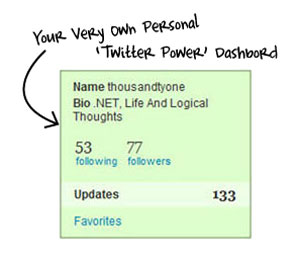Honest confession: I love twitter.
Having said that; twitter is by far the loudest when it comes to flaunting your so-called-social-networking-mussel-power on the web. Placed smack in the middle of every user's home page is what I like to call the 'Twitter Power' Dashboard.

As humble and low profile as this dashboard looks; it is one of the features that drives countless users to twitter and keeps them motivated for months as they work hard to 'collect' what twitter calls their 'followers'.
Put simply; the concept of 'followers' and the idea of flaunting the number of followers that follow you on your twitter-home-page is by far one of the biggest psychological gimmicks that I have witnessed in my entire online life till date; and guess what --- it works really well for twitter.
The reasons why it works are pretty obvious.
Joshua Porter in his blog-post on the topic; describes rather articulately why Twitter strikes a note with a huge audience and how it en-cashes on simple fundamental human nature; big time. He explains:
| Here’s a question: how would Twitter change for you if you didn’t know how many followers you have? What if the designers at Twitter removed the number from all screens/APIs and forced you to rely on replies or re-tweets to let you know what was going on? Would that be OK with you? How would it change your behavior? Humans are hard-wired for attention. My newborn girl, for example, cries when she’s not getting attention. My 3 year old, who isn’t used to not having attention, is going through a major psychological shift in her life because she’s realizing that she isn’t the only child in the universe... she now has a sister who will be getting attention as well. Attention is a core human issue for all of us. As designers we need to keep this in mind. |
What is actually scary about a feature of this sort is that even someone like Joshua; who is smart enough to understand the whole point cannot help but use the meta-data on every user that twitter flaunts on their twitter-home-page to come to his conclusions about the person. He explains:
| I use follower numbers in several ways to judge the type of person who is on the other end. If I’m followed by someone who has very low following/follower numbers, then I know they’re probably new to Twitter. If someone has really high following/follower numbers, then I know they’re probably an auto-follower, which suggests they might not focus on quality conversation as much as attention. If someone has high follower numbers and low following numbers, then I know they have an audience for some reason (it might not be a good reason). Obviously, these numbers don’t tell you everything… but I use them to give me an idea. When metadata is available… humans will look at it. |
While the analysis seems reasonable enough at the first glance; the fundamental issue here is realizing why twitter decided to throw the Twitter-Power dashboard on your face in the first place.
It was a design decision.
One that benefits Twitter tremendously.
The real question; that you; dear reader; need to ask yourself now is this --- how does it benefit you?
Does it nudge you to go out there and push meaningful content or does it nudge you to increase your follower-count by indulging in the You-Follow-Me-I-Follow-You funny dance that a huge percentage of twitter users dance?
As anyone who has run a blog for more than a year and has had more than a handful of subscribers will tell you; constantly peeking at your traffic and writing with the sole purpose of increasing it; is highly overrated.
Jeff Atwood describes this much more articulately than me:
| There's certainly value in audience metrics. But it's easy to overanalyze, too. Instead of obsessing over who does and doesn't link to you, concentrate on writing a blog entry you'd like to read. Instead of worrying about audience feedback, focus on delivering a presentation you'd like to attend. You should trust your gut more than any metrics. Build it, and they will come. |
With it's one-forty-one character limit; twitter makes writing something you would yourself like to read later really hard; With it's constant display of your statistics or traffic-meta-data; it makes worrying about the number of followers you have really easy.
If you; dear reader are on twitter; the real challenge is not how to increase your follower count.
The real challenge; dear reader; is in-fact; to turn a blind eye to your 'twitter-power' dashboard and focus on adding content that your readers and you yourself will love reading.
Now; go visit your twitter home page.
This time; try not to look at your follower count.
Focus on your past tweets section instead.
See if you can read through your very own twitter home page; read it; not get bored and get some genuine value out of it.
If you can't --- the number of followers you have; is just meta-data that doesn't mean a thing.
The whole idea of measuring 'Twitter Power' through number of followers is highly overrated.
Now go find meaningful ways to participate and contribute using that small one-forty-one-character text-box.
I wish you good luck.
Comments are closed.